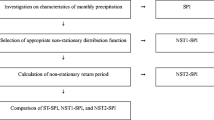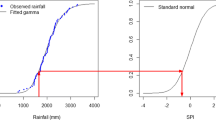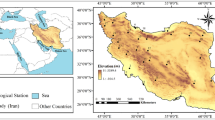Abstract
In a rapidly changing environment, a greater concern about the establishment and improvement of drought indices is expected. The main goal of this study is to develop and apply a time-dependent Standardized Precipitation Index (SPIt) that takes account of the possible non-stationary behaviors in precipitation records. Summer precipitation observations (1959 ~ 2011) from 21 raingauge stations in the Luanhe River basin are fitted with non-stationary Gamma distributions respectively by means of the Generalized Additive Models in Location, Scale and Shape (GAMLSS). The temporal variability of the distribution’s parameter (related to the mean) is flexibly described by an optimized polynomial function. Based on the non-stationary distribution, the SPIt is calculated and then employed to assess the spatio-temporal characteristics of summer drought in the basin. Results of the non-stationary modeling indicate an overall decreasing trend in the summer precipitation during 1959 ~ 2011, and especially a significant decrease in the period of 2000 to 2011. The SPIt is found to be more robust and reliable compared with the traditional Standardized Precipitation Index (SPI). Moreover, remarkable difference is observed between the historical drought assessments of SPIt and SPI in the Luanhe River basin, implying that the non-stationarity of hydrological time series cannot be ignored in drought analyses and forecasts. The proposed SPIt method can be a feasible alternative for drought monitoring under non-stationary conditions, intended to provide a valuable reference for further studies.







Similar content being viewed by others
References
Abramowitz M, Stegun IA (1965) Handbook of mathematical functions. Dover, New York
Akaike H (1974) A new look at the statistical model identification. IEEE Trans Autom Control 19(6):716–723
Angelidis P, Maris F, Kotsovinos N, Hrissanthou V (2012) Computation of drought index SPI with alternative distribution functions. Water Resour Manag 26(9):2453–2473
Bonaccorso B, Bordi I, Cancelliere A, Rossi G, Sutera A (2003) Spatial variability of drought: an analysis of the SPI in sicily. Water Resour Manag 17(4):273–296
Brillinger DR (2001) Time series: data analysis and theory. SIAM, Philadelphia
Chang NB, Vasquez MV, Chen CF, Imen S, Mullon L (2015) Global nonlinear and nonstationary climate change effects on regional precipitation and forest phenology in Panama, Central America. Hydrol Process 29(3):339–355
Coles S (2001) An introduction to statistical modeling of extreme values. Springer, London
Duan K, Mei YD (2014) Comparison of meteorological, hydrological and agricultural drought response to climate change and uncertainty assessment. Water Resour Manag 28:5039–5054
Dunn PK, Smyth GK (1996) Randomized quantile residuals. J Comput Graph Stat 5(3):236–244
El Adlouni S, Ouarda TBMJ, Zhang X, Roy R, Bobeé B (2007) Generalized maximum likelihood estimators for the nonstationary generalized extreme value model. Water Resour Res 43:W03410
Filliben JJ (1975) The probability plot correlation coefficient test for normality. Technometrics 17:111–117
Gilleland E, Ribatet M, Stephenson AG (2013) A software review for extreme value analysis. Extremes 16(1):103–119
Giraldo Osorio JD, García Galiano SG (2012) Non-stationary analysis of dry spells in monsoon season of Senegal River Basin using data from Regional Climate Models (RCMs). J Hydrol 450(27):82–92
Gunderlik JM, Burn DH (2003) Non-stationary pooled flood frequency analysis. J Hydrol 276:210–223
Hayes M, Svoboda M, Wall N, Widhalm M (2011) The Lincoln declaration on drought indices: universal meteorological drought index recommended. Bull Am Meteorol Soc 92:485–488
Hejazi MI, Markus M (2009) Impacts of urbanization and climate variability on floods in Northeastern Illinois. J Hydrol Eng 14(6):606–616
Held IM, Soden BJ (2006) Robust responses of the hydrological cycle to global warming. J Climate 19(21):5686–5699
Hosking JRM, Wallis JR (1997) Regional frequency analysis: an approach based on Lmoments. Cambridge University Press, Cambridge
Ishak EH, Rahman A, Westra S, Sharma A, Kuczera G (2013) Evaluating the non-stationarity of Australian annual maximum flood. J Hydrol 494:134–145
Jiang C, Xiong LH (2012) Trend analysis for the annual discharge series of the Yangtze River at the Yichang hydrological station based on GAMLSS. Acta Geograph Sin 67(11):1505-1514 (in Chinese with English abstract)
Kao SC, Govindaraju RS (2010) A copula-based joint deficit index for droughts. J Hydrol 380(1):121–134
Kendall MG (1975) Rank Correlation Methods. Griffin, London
Khaliq MN, Ouarda TBMJ, Ondo JC, Gachon P, Bobeé B (2006) Frequency analysis of a sequence of dependent and/or non-stationary hydro-meteorological observations: a review. J Hydrol 329:534–552
Li JZ, Feng P (2007) Runoff variations in the Luanhe river basin during 1956–2002. J Geogr Sci 17(3):339–350
Li YJ, Zheng XD, Lu F, Jing MA (2012) Analysis of drought evolvement characteristics based on standardized precipitation index in the Huaihe River basin. Procedia Eng 28:434–437
Li S, Xiong LH, Dong LH, Zhang J (2013) Effects of the three gorges reservoir on the hydrological droughts at the downstream Yichang station during 2003–2011. Hydrol Process 27(26):3981–3993
López J, Franćes F (2013) Non-stationary flood frequency analysis in continental Spanish rivers, using climate and reservoir indices as external covariates. Hydrol Earth Syst Sci 17(8):3189–3203
Ma HJ, Yan DH, Weng BS, Fang HY, Shi XL (2013) Applicability of typical drought indexes in the Luanhe River basin. Arid Zone Res 30(4):728–734 (in Chinese with English abstract)
Mann HB (1945) Nonparametric tests against trend. Econometrica 13:245–259
McKee TB, Doesken NJ, Kleist J (1993) The relationship of drought frequency and duration to time scales. In: 8th Conference on Applied Climatology. American Meteorological Society, Boston, MA, 179–184
McKee TB, Doesken NJ, Kleist J (1995) Drought monitoring with multiple time scales. In: 9th Conference on Applied Climatology, American Meteorological Society, Boston, MA, 233–236
Mishra AK, Singh VP (2010) A review of drought concepts. J Hydrol 391:202–216
Palmer WC (1965) Meteorologic Drought. US Department of Commerce, Weather Bureau, Research Paper 45:58
Palmer WC (1968) Keeping track of crop moisture conditions, nationwide: the new crop moisture index. Weatherwise 21:156–161
Pasho E, Camarero JJ, de Luis M, Vicente-Serrano SM (2011) Impacts of drought at different time scales on forest growth across a wide climatic gradient in north-eastern Spain. Agr Forest Meteorol 151(12):1800–1811
Patel NR, Chopra P, Dadhwal VK (2007) Analyzing spatial patterns of meteorological drought using standardized precipitation index. Meteorol Appl 14:329–336
Paulo AA, Pereira LS (2006) Drought concepts and characterization: comparing drought indices applied at local and regional scales. Water Int 31:37–49
Rigby RA, Stasinopoulos DM (1996a) A semi-parametric additive model for variance heterogeneity. Stat Comput 6:57–65
Rigby RA, Stasinopoulos DM (1996b) Mean and dispersion additive models. Statistical theory and computational aspects of smoothing. Physica-Verlag, Heidelberg, pp 215–230
Rigby RA, Stasinopoulos DM (2005) Generalized additive models for location, scale and shape. Appl Stat 54:507–554
Russo S, Dosio A, Sterl A, Barbosa P, Vogt J (2013) Projection of occurrence of extreme dry-wet years and seasons in Europe with stationary and nonstationary standardized precipitation indices. J Geophys Res Atmos 118:7628–7639
Salas JD (1993) Analysis and modeling of hydrologic time series. In: Maidment DR (ed) Handbook of hydrology. McGraw-Hill, New York
Schwarz G (1978) Estimating the dimension of a model. Ann Stat 6(2):461–464
Serinaldi F, Kilsby CG (2015) Stationarity is undead: uncertainty dominates the distribution of extremes. Adv Water Resour 77:17–36
Shafer BA, Dezman LE (1982) Development of a Surface Water Supply Index (SWSI) to assess the severity of drought conditions in snowpack runoff areas. In: Preprints, Western SnowConf., Reno, NV, Colorado State University, 164–175
Shukla S, Wood AW (2008) Use of a standardized runoff index for characterizing hydrologic drought. Geophys Res Lett 35(2):L02405
Sol’áková T, De Michele C, Vezzoli R (2014) A comparison between parametric and non-parametric approaches for the calculation of two drought indices: SPI and SSI. J Hydrol Eng 19(9):04014010
Stasinopoulos DM, Rigby RA (2007) Generalized additive models for location scale and shape (GAMLSS) in R. J Stat Softw 23(7):1–46
Strupczewski WG, Singh VP, Feluch W (2001) Non-stationary approach to at-site flood frequency modeling I. Maximum likelihood estimation. J Hydrol 248:123–142
Strupczewski WG, Kochanek K, Feluch W, Bogdanowicz E, Singh VP (2009) On seasonal approach to nonstationary flood frequency analysis. Phys Chem Earth 34:612–618
Szalai S, Szinell C, Zoboki J (2000) Drought monitoring in Hungary. In: Early Warning Systems for Drought Preparedness and Drought Management, WMO, Geneva, 161–176
Tabari H, Nikbakht J, Hosseinzadeh Talaee P (2013) Hydrological drought assessment in northwestern Iran based on Streamflow Drought Index (SDI). Water Resour Manag 27(1):137–151
Türkeş M, Tatl H (2009) Use of the standardized precipitation index (SPI) and a modified SPI for shaping the drought probabilities over Turkey. Int J Climatol 29(15):2270–2282
Vasiliades L, Galiatsatou P, Loukas A (2015) Nonstationary frequency analysis of annual maximum rainfall using climate covariates. Water Resour Manag 29(2):339–358
Vicente-Serrano SM (2006) Differences in spatial patterns of drought on different time scales: an analysis of the Iberian Peninsula. Water Resour Manag 20(1):37–60
Vicente-Serrano SM, López-Moreno JI (2008) Nonstationary influence of the North Atlantic oscillation on European precipitation. J Geophys Res Atmos 113(D20):347–348
Vicente-Serrano SM, Beguería S, López-Moreno JI (2010) A multiscalar drought index sensitive to global warming: the standardized precipitation evapotranspiration index. J Climate 23:1696–1718
Vicente-Serrano S, López-Moreno J, Beguería S, Lorenzo-Lacruz J, Azorin-Molina C, Morán-Tejeda E (2012) Accurate computation of a streamflow drought index. J Hydrol Eng 17(2):318–332
Villarini G, Smith JA, Serinaldi F, Bales J, Bates PD, Krajewski WF (2009a) Flood frequency analysis for nonstationary annual peak records in an urban drainage basin. Adv Water Resour 32(8):1255–1266
Villarini G, Serinaldi F, Smith JA, Krajewski WF (2009b) On the stationarity of annual flood peaks in the continental United States during the 20th Century. Water Resour Res 45(8):W08417
Villarini G, Smith JA, Napolitano F (2010) Nonstationary modeling of a long record of rainfall and temperature over Rome. Adv Water Resour 33(10):1256–1267
Villarini G, Smith JA, Serinaldi F, Ntelekos AA (2011) Analyses of seasonal and annual maximum daily discharge records for central Europe. J Hydrol 399:299–312
Wagesho N, Goel NK, Jain MK (2012) Investigation of non-stationarity in hydro-climatic variables at Rift Valley lakes basin of Ethiopia. J Hydrol 444:113–133
Wang WG, Shao QX, Yang T, Peng SZ, Xing WQ, Sun FC, Luo YF (2013) Quantitative assessment of the impact of climate variability and human activities on runoff changes: a case study in four catchments of the Haihe River Basin, China. Hydrol Process 27(8):1158–1174
Wang YX, Li JZ, Feng P, Chen FL (2015) Effects of large-scale climate patterns and human activities on hydrological drought: a case study in the Luanhe River basin, China. Nat Hazards 76:1687–1710
Wei ZZ, Feng P (2011) Analysis of rainfall-runoff evolution characteristics in the Luanhe River basin based on variable fuzzy set theory. J Hydraul Eng 42(9):1051–1057 (in Chinese with English abstract)
Wen L, Rogers K, Ling J, Saintilan N (2011) The impacts of river regulation and water diversion on the hydrological drought characteristics in the Lower Murrumbidgee River, Australia. J Hydrol 405(3):382–391
Wilhite DA, Svoboda MD, Hayes MJ (2007) Understanding the complex impacts of drought: a key to enhancing drought mitigation and preparedness. Water Resour Manag 21(5):763–774
Wilson D, Hisdal H, Lawrence D (2010) Has streamflow changed in the Nordic countries? - Recent trends and comparisons to hydrological projections. J Hydrol 394:334–346
Xiong LH, Du T, Xu CY, Guo SL, Jiang C, Gippel CJ (2015) Non-stationary annual maximum flood frequency analysis using the norming constants method to consider non-stationarity in the annual daily flow series. Water Resour Manag 29(10):3615–3633
Yang YH, Tian F (2009) Abrupt change of runoff and its major driving factors in Haihe River Catchment, China. J Hydrol 374:373–383
Yang ZY, Yuan Z, Fang HY, Yan DH (2013) Study on the characteristic of multiply events of drought and flood probability in Luanhe River basin based on Copula. J Hydraul Eng 44(005):556–561 (in Chinese with English abstract)
Yoo JY, Kwon HH, Kim TW, Ahn JH (2012) Drought frequency analysis using cluster analysis and bivariate probability distribution. J Hydrol 420–421:102–111
Zhang ZX, Chen X, Xu CY, Yuan LF, Yong B, Yan SF (2011) Evaluating the non-stationary relationship between precipitation and streamflow in nine major basins of China during the past 50 years. J Hydrol 409(1–2):81–93
Zhang AJ, Zhang C, Fu GB, Wang BD, Bao ZX, Zheng HX (2012) Assessments of impacts of climate change and human activities on runoff with SWAT for the Huifa River Basin, Northeast China. Water Resour Manag 26(8):2199–2217
Acknowledgments
This work was financially supported by the National Natural Science Foundation of China (No. 51479130). The authors thank the Hydrology and Water Resource Survey Bureau of Hebei Province for providing the observed precipitation data.
Author information
Authors and Affiliations
Corresponding author
Rights and permissions
About this article
Cite this article
Wang, Y., Li, J., Feng, P. et al. A Time-Dependent Drought Index for Non-Stationary Precipitation Series. Water Resour Manage 29, 5631–5647 (2015). https://doi.org/10.1007/s11269-015-1138-0
Received:
Accepted:
Published:
Issue Date:
DOI: https://doi.org/10.1007/s11269-015-1138-0




